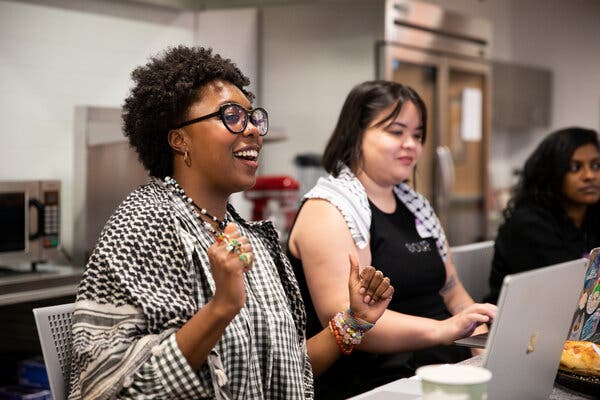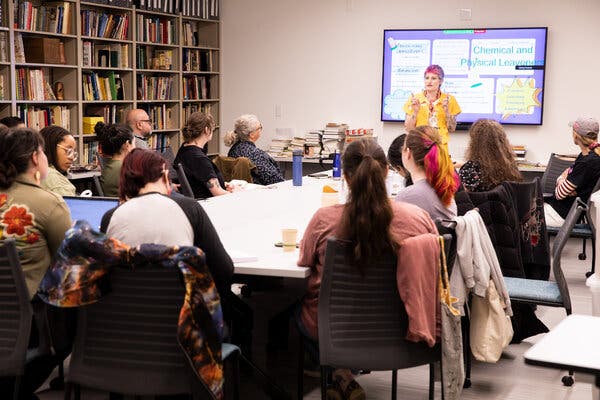At Boston University, scholars, students and writers gathered to share thoughts on the role of gender and sexuality in the food space. Snacks were plentiful.
When Sasha DuBose uses the word “queer” to talk about food, it’s a verb, not an adjective. To Ms. DuBose, queering food is “taking how we define food and how we engage with it and twisting it, making it more fun.”
To them, queer food is also okra.
“They way you slice into okra and it’s crunchy and ooshy-gushy — a lot of people think it’s weird,” said Ms. DuBose, a nonbinary transgender lesbian who will soon graduate from the food studies program at New York University. “But okra is queer.”
Queer food can be so many things, depending who’s cooking, eating or serving. During the conference, queer food was defined as meals made by queer chefs and home cooks. But it was also far broader, almost without boundaries. It was the pie thrown in the face of the anti-gay rights activist Anita Bryant, the gastro-narratives of queer people in El Paso, Texas, and the food served at “topless lesbian gatherings,” as one panelist described it.
“Queer food defies categorization, and that’s its beauty,” said Megan J. Elias, who organized the conference with Alex D. Ketchum, an assistant professor at the Institute for Gender, Sexuality and Feminist Studies at McGill University in Montreal.
Ms. DuBose and Ms. Elias were among the some 160 food scholars, writers, students and industry professionals who last weekend paid $45 apiece to gather online and in classrooms and a cookbook library at Boston University for the inaugural Queer Food Conference. The mostly Millennial and Gen Z attendees considered food (pie, seaweed), food culture (potlucks, cookbooks) and food spaces (a co-op, clambakes) through queer, Marxist, feminist and anti-colonialist perspectives.

The goal of the event was to reclaim histories and imagine futures, not of a cuisine — queer food has no set taste profiles or geographic origins — but of food that “challenges binaries and any kind of normativity,” said Ms. Elias, the director of the Gastronomy and Food Studies Programs at Boston University. (Jacques Pépin and Julia Child founded the gastronomy master’s program in 1991.)
Despite the academic language, it wasn’t all brainy abstractions. A presentation entitled “Deaccessioned Because Sticky: Faux Food in Decorative Arts Museums,” for instance, found camp in plastic vegetables. The conference issued a slim cookbook that doubled as a program; recipes included a haggis porridge, vegan cheesecake and, yes, Ms. DuBose’s okra stew. (For stock, they suggest “leftover potlikker from collard greens.”)
And it wasn’t the only queer food event in town: On Sunday night, some of the conference goers made their way over to the High Street Place food hall in downtown Boston to sample “gay clam chowder” and “Sapphic sticky ribs,” from L.G.B.T.Q. chefs including Tiffani Faison and Kareem Queeman, at the Big Queer Food Fest, a culinary event that coincided with the conference.
David Lewis, who founded the traveling festival with Chad Hahne, said it was a chance to experience queer food as “a way of eating and cooking and being together.”
Among the more high-profile speakers at the conference was John Birdsall, the James Beard biographer (and James Beard Award winner) whose new book, “What Is Queer Food?”, is to be published next spring. He said queer food sometimes doesn’t even need to mean food, but rather “food in context.”
“It’s not about specific recipes or dishes,” Mr. Birdsall said. “It’s everything around those dishes, how they got to the table, who’s eating them, who’s serving them.”
It’s who’s doing the growing, too: In 1991, K Greene got hired at the Limelight in New York City to party with club kids. These days, they’re a farmer who runs the Hudson Valley Seed Company with their partner, Doug Muller. At the conference, Mx. Greene and Chris Keeve, a student from Kentucky, collaborated on a session called “Nonbinary Botany.”
The pleasure of queer food, Mx. Greene said, was in “being part of the reproductive life cycle of plants, and seeing the incredible diversity of expression that plants have.”
The concept of queer food is not new. Food & Wine and Bon Appétit have covered it. Queer meal-making has long driven social and advocacy groups like the Queer Food Foundation and Queer Soup Night, and restaurants like HAGS in the East Village, where the motto is “by Queer people for all people.”
Multinational corporations have even used queer food — nakedly and successfully — in their marketing tool, as when Taco Bell sold out a nationwide drag brunch tour two years ago. And come June, rainbow-colored cookies will again line bakery shelves for Pride Month.
Mr. Birdsall said to understand queer food in practice, think of created-family meals like Friendsgiving, or the Rosh Hashana dinners at Sha’ar Zahav, a queer-welcoming synagogue in San Francisco where, as far back as 1977, men did the cooking and women blew the shofar.
“For many queer people, the intentional family has become more meaningful than blood family,” he said. “That’s a way that food became queer, by redefining family life, by rewriting the gender rules of cooking.”
For Isabel Marie Barbosa, a transgender and trans-disciplinary artist, queer food tastes like tart lime and fatty cream. In their session, they brought two pillowy Key lime pies made from a recipe in the “Get Fat, Don’t Die!” column of Diseased Pariah News, Beowulf Thorne’s darkly comic, H.I.V./AIDS-themed zine from the early ’90s that offered a “a forum for infected people” to share their “writing and brownie recipes,” as the first issue explained.
Mx. Barbosa, who’s getting a master’s degree in gastronomy from Boston University, also brought along a “sleazy wine cake,” made with Marsala and coconut, and a pecan buttercrunch — recipes from the zine that they tested and ate with a friend who was recovering from top surgery.
“When we’re looking at the political climate, there’s something especially important about being there for our more vulnerable community members,” they said. “Food is community care.”
